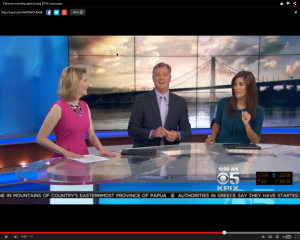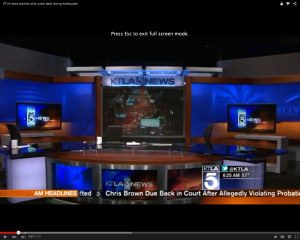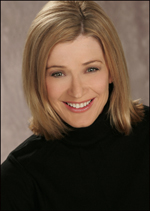When News Breaks!

San Francisco TV morning news shows were on-air during an earthquake. So how did they do?
A magnitude 4.0 earthquake rattled the San Francisco Bay area while local news stations were on the air with their morning shows. Watch how two different stations mishandled the shakeup.
KTVU’s meteorologist was at the weather map, sharing a viewer tweet related to the ongoing wildfires. His comments: “Oh my goodness… that was a big ‘un…” before tossing back to the anchors, who fumbled a toss to break. Most viewers, at this point, probably started switching channels to see if the other stations had a clue.
KPIX was in the middle of a v/o feature story on drones, interrupting the video to go back to the anchors. They commented, “definitely an earthquake” and “we’re going to work with our producers” to figure this out. One anchor commented about a quake he experienced in 2011 — completely useless to the audience who wants to know why they are shaking now. Anyone who hadn’t already changed the channel heard the reporter say she couldn’t wait to tell her mom in Alabama about it. An out-of-towner is covering this? Then they tossed to a “quick break.” Most viewers in tech-savvy San Francisco were probably long gone by then, checking online or on mobile platforms for the needed information.
Seriously, is this the best you can do in a top 10 market where earthquakes are a fairly common occurrence? It’s even more inexcusable because these anchors all appear to have tablets, computers and perhaps even their phones at the desk. Here’s what they should have done:
REASSURANCE: Your first job in breaking news is to assure the viewers you have it covered. Tell the viewers you are checking to find out the preliminary magnitude and the epicenter. It’s okay to say what you don’t know, and how you are working to find answers.
TECHNOLOGY: Put those devices on your desk to good use. Let the viewers see you immediately checking the USGS website and put it on the screen if possible. Check local law enforcement feeds. While we’re at it, don’t use outdated terms like “Richter scale,” which I heard recently in another market that experiences earthquakes. If tornadoes or other natural disasters are common in your market, know the go-to web sites for info when news breaks.
TEAMWORK: While one anchor is looking online, the other should be ad-libbing about what you are doing to cover the story. Remind people of what they can do to stay safe. Get everyone on the set involved. Can the weather or traffic person punch up a traffic cam or weather beauty shot, just to give us a live look outside? Do you have a reporter in the field for another live shot who might have felt it?
OUTREACH: Solicit viewer tweets, photos and Facebook posts. (All the usual rules about verification apply.)
Should you dive under the desk and risk becoming a viral video? Depends on how serious it is. Safety first. Frankly, most TV stations in earthquake zones should have secured their studio lights by now, but you never know. Avoid leaving the desk empty or tossing to a break when the viewers need you most.
You don’t want to be caught with a deer-in-the-headlights reaction when your viewers need you most. In this case, some major market talent came across as prompter-readers who need to go to a break and check with a producer to cover the actual news. We practice these scenarios in talent coaching so that when news breaks out, you won’t break down.

KTLA anchors took a dive when their studio started shaking, leaving the desk empty when the viewers needed them most.
Tweet





 Hi, I'm Terry Anzur. I've been a professional multimedia journalist for more than 30 years, anchoring and reporting everywhere from New York to Los Angeles to West Palm Beach. I've taught on-air skills to journalists of all levels, both through positions at the University of Southern California and Pepperdine University and through my own independent company.
Hi, I'm Terry Anzur. I've been a professional multimedia journalist for more than 30 years, anchoring and reporting everywhere from New York to Los Angeles to West Palm Beach. I've taught on-air skills to journalists of all levels, both through positions at the University of Southern California and Pepperdine University and through my own independent company.